
Hands on with the Garmin GPSMAP 62s
It’s finally here… The Garmin GPSMAP 62s brings a long-awaited update to the fabled and much-loved GPSMAP 60CSx, which has reigned supreme as the gold standard handheld GPS for more than four years. During that time, Garmin experimented with new interfaces, first with the Colorado series, and later with the Oregon and Dakota lines. These have been fine-tuned through many software updates, adding things like paperless geocaching and
the ability to add custom maps and aerial imagery.
With the 62 series (and the boater friendly companion 78 series, which shares the same interface), Garmin has married the best features of the 60/76 models, with many of the advantages of the Oregon line.
The problematic high-resolution screens found on the Colorado and Oregon lines did not make it to the 62 series (although I should note that this problem has largely been solved in the latest model, the Oregon 450). Before we get into the details, lets look at some closely…
Related models
- Drop down a notch to the GPSMAP 62 and you’ll lose wireless data sharing, the barometric altimeter, triaxial electronic compass and the micro-SD slot; still, this one has enough internal memory to satisfy most people’s needs
- Going the other direction, the GPSMAP 62st adds pre-loaded 1:100,000 scale US topo maps to the features found on the 62s, but with all the free maps available, there’s little reason to bump up to this model
- But you might want to step up to the 62sc to add a 5MP geotagging camera
- To see how the GPSMAP 62s stands up against other Garmin models, check out my Garmin handheld GPS comparison chart
I’ll discuss the display and feature set first, then look at performance
Portions of the following were adapted from my review of the previously released Garmin GPSMAP 78s and other units with shared features.
Garmin GPSMAP 62s display
With transflective TFT screens, the greater the pixel density, the less light that can be reflected back to the user. In order to maintain the bright screen found on the 60/76 series, Garmin left the resolution (160 x 240 pixels) alone. Screen size remains unchanged too, at 1.6 x 2.2”. The 62 and 78 series do enjoy an increased range of colors that can be displayed (65,000 vs. 256 in the 60/76 series). The result is a bright display, not quite as large or as high resolution as the Oregon series, but with much better visibility in a wide range of conditions. I definitely noticed the lower resolution, but these are the tradeoffs you make. The only time the screen seems cramped to me is when I have a dashboard showing on the map screen (discussed more below).
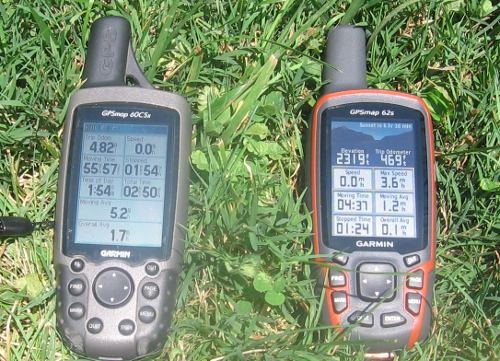
Shown above is a photo taken in full sun, without backlight, comparing the 60CSX and 62s. It is difficult to capture screen visibility on film, but I find these two displays comparable in a wide range of conditions.
Garmin GPSMAP 62s interface
Garmin hit a home run on the interface. They did an excellent job taking the best aspects of the Oregon series and making it work on a non-touchscreen unit. I think it is actually better than the Oregon except for when it comes to text-entry, where the touchscreen excels. The 62/78 series interface makes it much quicker to navigate main menu items.
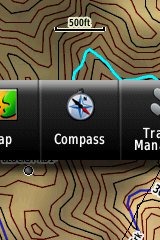 A Page Ribbon menu appears when you press the Page or Quit buttons (see image at right). Just like on the 60/76 series, these buttons advance through pages in forward or reverse order, respectively.
A Page Ribbon menu appears when you press the Page or Quit buttons (see image at right). Just like on the 60/76 series, these buttons advance through pages in forward or reverse order, respectively.
The Page Ribbon menu item that appears is the next screen in the sequence. After a second or two, that screen will automatically open. Or you can press Enter to go there right away, or continue pressing Page or Quit to advance to other pages in the sequence; stop on one and it will open. Page Ribbon items and their order can be customized. I prefer this interface to the old style, but you may not. In that case, you can set the unit to a classic style menu and get the old 60/76 series functionality, eliminating the Page Ribbon.
Here’s a quick video I shot, showing a bit of the interface:
Newer features on the Garmin GPSMAP 62s
The 62 series inherited a number of features from the Colorado, Dakota and/or Oregon series. These include the ability to utilize Garmin custom maps and BirdsEye aerial imagery, a tri-axial compass, new customization options, advanced track navigation, wireless data transfer and paperless geocaching. None of these were available on the 60/76 series; I’ll explore each in more detail.
Custom maps and BirdsEye imagery
Garmin custom maps allows you to put just about any map image on the 62s. Found a PDF park trail map online? Add it to your GPS! The image at left below shows a custom map — a USGS topo (raster) image. You can read more about this feature by checking out my posts on Garmin custom maps.
With Garmin’s BirdsEye aerial imagery program, a $29.99 annual subscription allows you to add aerial imagery to the GPSMAP 62s. Since I don’t yet have a BirdsEye subscription for my unit, I’m showing a Jefferson Memorial aerial image using Garmin custom maps, but hey, you get the idea.
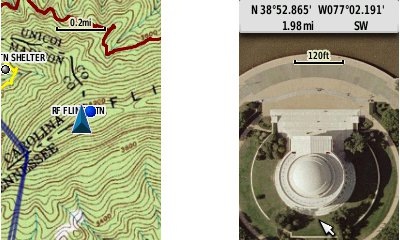
Tri-axial compass
Having a tri-axial compass means you don’t have to hold the unit level while navigating. The downside is that the calibration process is more complicated than that for a two-axis electronic compass. It’s the same procedure that is used on the Dakota 20 and Oregon x50 series — here’s a brief video I shot of it. The compass should be recalibrated every time you change the batteries in the unit.
Customizing the Garmin GPSMAP 62s
The 62s offers lots of options for customization. I highly recommend you take the time to set up the following.
Page sequence – You can customize the page sequence by choosing Main Menu > Setup > Page Sequence. This will allow you to select which pages appear in the page sequence and their order. The Page and Quit buttons move forward and backwards (respectively) through pages. I usually put the map screen as my first page and the trip computer last; this way I can toggle between them with the page and quit buttons.
Profiles – The 62s comes with recreational, geocaching, automotive, marine, fitness and classic profiles. You can switch profiles by going to Main Menu > Profile Change. Or create a new one by going to Main Menu > Setup > Profiles. Select the new profile to give it a name. Any changes you make in menus or other settings will be retained in that profile. So start changing things! Want track up when geocaching and north up when biking? No problem. How about a separate profile that just shows USGS topos or aerial imagery? The possibilities are nearly endless.
Data fields – You can change data fields on just about any screen that has these; simply press Menu > Change Data Fields.
Dashboards – Instead of data fields (and in some cases in addition to), you can select a dashboard for the map, compass and trip computer screens. Choices (depending upon page) may include automotive, stopwatch, small or large data field, recreational, compass, geocaching or elevation plot. I’ve included screenshots showing the last four below. For the trip computer and compass pages, you access this via Menu > Change Dashboard. For the map screen, choose Menu > Setup Map > Data Fields > Dashboard. The one downside here is the small screen on the 62 series; using a dashboard can significantly reduce map real estate.

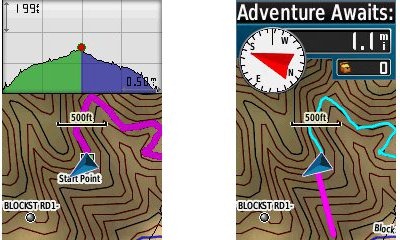
Track navigation
 With the GPSMAP 62s, you can select a track to navigate and a route will be created. Waypoints are automatically generated for major high and low elevation points, and start and finish; these and any user waypoints along the track are added to the route. I’m a heavy user of track navigation. If I head out for a trail I’ve never traveled before, I do a search online for tracks (favorite search terms are .gpx, gps, trail name, and park name) and load the track to the device. One advantage of this new track navigation feature is that, unlike typical backcountry route navigation, you’ll get an estimate of actual trail distance rather than “as the crow flies” mileage. Screenshot at right.
With the GPSMAP 62s, you can select a track to navigate and a route will be created. Waypoints are automatically generated for major high and low elevation points, and start and finish; these and any user waypoints along the track are added to the route. I’m a heavy user of track navigation. If I head out for a trail I’ve never traveled before, I do a search online for tracks (favorite search terms are .gpx, gps, trail name, and park name) and load the track to the device. One advantage of this new track navigation feature is that, unlike typical backcountry route navigation, you’ll get an estimate of actual trail distance rather than “as the crow flies” mileage. Screenshot at right.
Paperless Geocaching
The 62 series is a nice GPS for geocaching, as it is set up for full paperless support, meaning you can see the description, logs, and hint, and you can log your attempt (find, DNF, etc.) for later transfer back to geocaching.com. Speaking of which, full access to these features requires a premium membership at geocaching.com. Shown below, clockwise from top left: closest geocaches, geocache description, map with geocaching dashboard, recent logs.
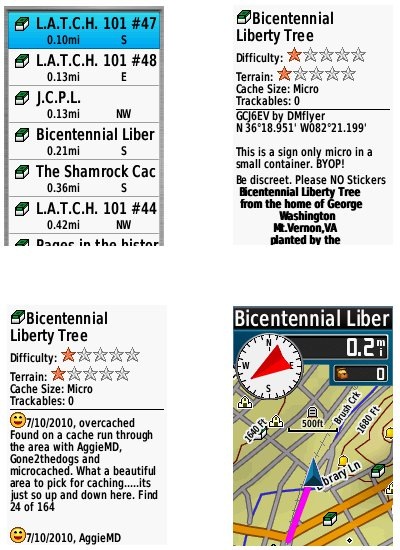
Wireless data transfer
The GPSMAP 62s is capable of wireless data transfer with other compatible Garmin units. You can transfer waypoints, tracks, routes and paperless geocache details.
Other features of note
Most of the following aren’t that new, but they are worth mentioning anyway:
Route, Track and Waypoint management 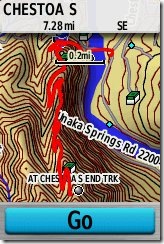
The GPSMAP 62 series has excellent route, track and waypoint management tools, including:
- Waypoints – The ability to project a waypoint, average location, set proximity alerts, and to reposition a waypoint at your current location.
- Tracks – You can choose to hide or show multiple tracks on the map, view an elevation plot, and give them a custom color (17 colors are available). The image at the right shows a track in red (a record of a previous trip). The color of the active track may also be changed. There’s a good thread at the GPSMAP wiki that delves more into track archiving and storage. The 2.44 beta firmware update brought additional archiving improvements; hopefully this will make it to a non-beta release soon.
- Routes – You can view a map of the entire route, edit the route, reverse it and view an elevation plot.
Ability to utilize free maps
One of the most awesome things about Garmin mapping units is the huge number of free maps available. My favorite site for these is http://gpsfiledepot.com where you can find 1:24,000 scale vector topo maps for most states. You can see a sample in the bottom two screen shots below. If you want shaded relief though (shown in the first two shots), you’ll need to go with Garmin’s own product, either Topo US 100K or their new 1:24,000 scale series.
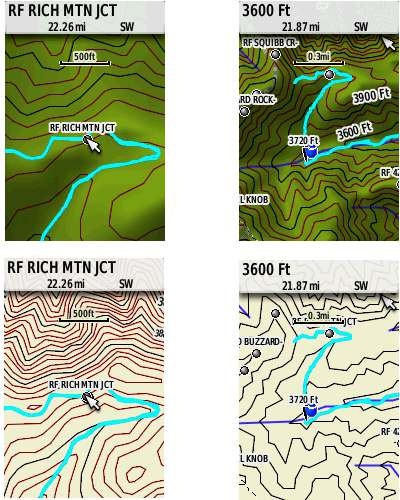
Auto use
While I would prefer the Oregon 450 as a dual use unit, due to its touch screen (which is significantly larger too), the 62 series is capable of giving turn-by-turn directions when loaded with City Navigator maps.
Under the flap and inside
Under the protective weather cap is a mini-USB port and MCX external antenna connection. Just so it doesn’t trigger questions, I’ll mention that the item beside the antenna connection is a screw. Inside the battery compartment is a micro-SD slot for additional map and data storage.
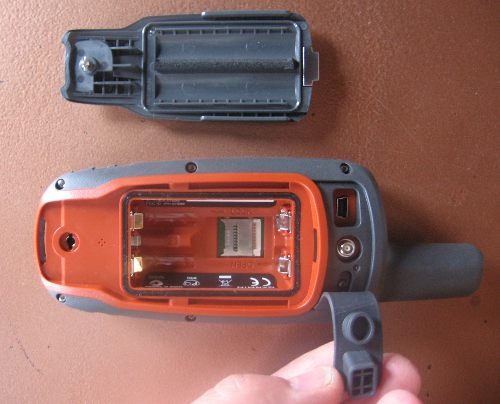
One hardware note here. The battery holders can be very tight with rechargeable NiMH batteries. I actually had to pry the batteries out of one unit I tested, though my wife could remove them with her amazingly strong fingernails! The batteries popped out of the other test units with a good slap, and I expect that even tight ones will loosen up over time.
Carabiner and mounting system
A rail mount on the back of the unit allows the included carabiner to slide onto the device (shown below). This is the same system used on the Colorado, Dakota and Oregon lines so the related accessories are interchangeable. I’ve heard some people say they don’t trust the carabiner mount, but after using it on my Oregon for a couple of years, I can say that I’ve never had any problems with it. Personally, I really like it and find it very convenient for clipping onto my pack.
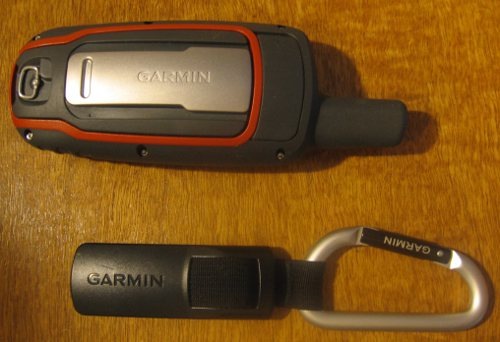
Garmin’s bike mount uses the same system, as shown below. I didn’t like this at first, since it’s just a zip tie system, but after a reader suggested using pliers (to pull the zip tie tight) and a screw driver (to press against the base of the zip tie slot), I’ve found that I can get it quite tight. I’ve never had a unit pop off the mount, though it is possible to slide it on incorrectly, so be aware of that. Also, low profile mounts such as this one seem much safer to the rider, in case of a crash, than ones that protrude.
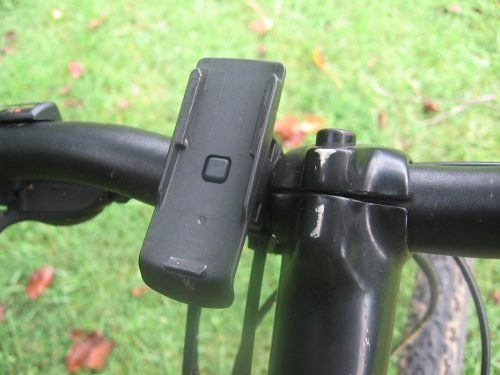
Auto mount kits that utilize this rail mount connection are also available.
Garmin GPSMAP 62s performance
UPDATE: The issues discussed below seem to have been resolved, and I am now very happy with my own 62s.
A tale of three units
I requested a GPSMAP 62s from Garmin and immediately put it on my mountain bike and went out for a test run. I was pretty shocked at the tracklog errors I saw. The unit also exhibited some abnormal behaviors just sitting still under open sky, with a lot of cycling between low and high readings. I talked to Garmin support, tried a hard reset – everything I could think of, but still saw these problems. At this point, I assumed I had a defective unit and arranged for them to send me a replacement…
Unit # 2 was better, but I still saw high accuracy readings (80’+) and some tracklog errors when mountain biking. I was seeing no such problems reported in GPS forums, so what was going on? Unlike the first one, the second unit appeared to be a pre-production model, further muddying the waters. I was beginning to feel pretty unlucky. Had I really received two dogs in a row? The sister unit, the GPSMAP 78s, had been so good. What in the world was going on?
Third unit and a theory
So I decided I needed another unit to test and, suspecting that Garmin might take a dim view of sending me a third unit, I went down to REI and plunked down my own money’; I figured I’d end up buying one anyway. When it gave me less than stellar results, a theory started forming in my oh too slow gray matter.
I never tested the 78s on my bike, because it didn’t work with standard mounts. Could it be that these new models had problems under canopy, at speed? While I was seeing wide swings in accuracy readings, the tracklogs looked pretty good except on downhill runs. After a couple of weeks of struggle, I had a theory to test. So lets break down performance by use and environment:
Mountain biking (speed + canopy)
Notes on methodology – Tracks were set up to record points every five seconds, WAAS was enabled. The 62s and my 60CSX were both mounted on opposite sides of my handlebars, in a position closer to horizontal than vertical.
The image below shows a portion of the 62s tracklog from a representative out and back trip. On the downhill run there are numerous places where the track doesn’t match well with what was recorded on the way up. In one place the error approaches 250’.
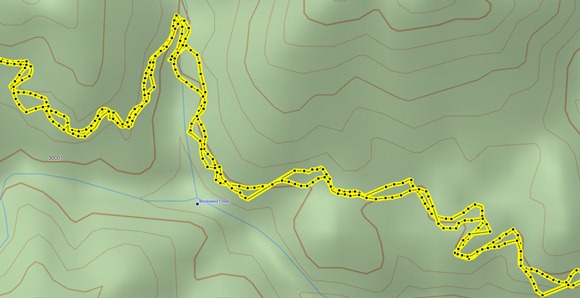 Compare this to the same section of 60CSx track below, where track separation maxes out at around 65’.
Compare this to the same section of 60CSx track below, where track separation maxes out at around 65’.
However, the 60CSx exhibited much worse spidering / scattering at rest stops, up to 150’ at one point, shown below (60CSx in blue, 62s in yellow).

Enter the beta
In my final round of tests before posting this review, I installed the 2.44 beta firmware, which also updated the GPS firmware to version 4.52. You can see in the 62s track below that these wild errors appear to be gone. I did see track separations of up to 110’ on the uphill and downhill runs, but nothing as large as the previous errors.

On the same ride, the 60CSx also showed track separation errors of around 110’, and once again exhibited significant spidering/multipath errors when stopped.
It appears that the 2.44 beta has significantly improved performance for mountain bikers and others who use their GPS receivers under canopy at faster than walking speeds. Except where indicated, the remainder of the tests discussed below were made using non-beta software.
Hiking under canopy
Here I used the same methodology I did when testing the 78s:
Recordings were made out and back, on foot, with the 78s in my right hand, and the 60CSx in my left. This meant that one unit may have been closer to a cut slope on the trip up, but the other unit was in this position on the trip down.
Tests were made in multiple locations. Basically, I saw more instances of tracklog separation with the 62s; these were in the 35-50’ range. I saw less of these with the 60CSX, but it threw larger variances, up to about 80’. And again, the 60CSx exhibited much more “spidering” when stopped.
Speed or canopy?
So going fast under canopy was problematic in my early testing, but going slow under canopy wasn’t so bad. How about speed alone? To test this, I stuck both units on my car’s dashboard and recorded tracks while driving. Both performed very well, though the 62s went off by about 70’ at one point. The issue appeared to be more about the combination of speed and leaf canopy, than about either alone, but again, it looks like the recent beta has largely fixed this.
Geocaching performance
I did some geocaching testing, but it is much harder to draw a conclusion here. Generally, the 62s put me a little closer and tended to settle down significantly faster than the 60CSx. One time, when standing 3 feet from a cache, it showed me 2’ away, with the compass pointing almost directly to the cache. Impressive! But alas, I am at the whims of the accuracy of the published coordinates when geocaching.
Battery life
I tested battery life using freshly charged Sanyo Eneloop batteries with the backlight off, and left it sitting under light canopy, undisturbed until the unit shut down. The unit was set to collect trackpoints every 30 seconds. The tracklog and total time data field showed that the unit ran for 17 hours and 59 minutes, a couple hours shy of the rated battery life of up to 20 hours.
Altimeter
In my most recent tests, with the 2.40 and 2.44 firmware, I found total ascent readings to be very accurate, on par with the 60CSx, which has always been my most reliable indicator of elevation gain. I was pleased to see this, since the Oregon series has bounced back and forth between accurate and inaccurate readings, depending upon firmware version.
Creaks and bugs
There have been a lot of reports on message boards about units that creak when pressed on opposite sides of the case. I have seen, um, heard this on each of the three units I tested. On the first, you could hear it when powering the unit of and off. It wasn’t as bad on the other two I tested. Whether this portends other problems over the life of the unit is unknown.
With new handhelds, you can typically expect some bugs in the early firmware. The 62s certainly has these, but many are minor or esoteric. One of the more common and unresolved complaints I’ve heard is that the reported battery level stays on full, and then drops to 3/4 charge shortly before the battery dies. Until this is fixed, when the battery level shows any drop, it’s nearly time to change to a new set!
Garmin GPSMAP 62s tips
I imagine there are more, but here’s a few tips:
- Use the zoom buttons to jump a full page in a menu
- When entering a name, the zoom buttons will switch between keypads
- You can create a custom startup message (e.g., if found, please call…) by connecting it to your computer and editing the Garmin/startup.txt file
- The 60 series header showing battery status is gone; you can check the 62 series battery level by briefly pressing the power button, but you may also want to dedicate a data field to it.
Garmin GPSMAP 62 pros
- Excellent menu system; fast access to features
- Bright screen
- Ability to load Garmin custom maps and BirdsEye aerial imagery
- Paperless geocaching
- Tri-axial compass
- Extensive customization options
- Advanced track navigation
- Wireless data transfer with compatible units
- Accurate total ascent readings
- Generally accurate tracklogs, especially with latest beta firmware
Garmin GPSMAP 62s cons
- Small, low resolution screen
- Text entry more difficult than on a touchscreen Oregon
- Relatively heavy (compared to Oregon series)
- Most units seem to sport a creaky case
- Firmware still seems a bit immature
Conclusion and recommendations (updated)
Updated to reflect my testing of production (non-beta) firmware version 2.50.
Recommended. Garmin has nailed the user interface, and the improved performance under the 2.50 firmware has eliminated my previous reluctance about tracklog accuracy. Is it as good as the 60CSx under any and all conditions? Possibly not, but it does show a lot less multipath error when standing still. And it seems to settle down a lot quicker. Those two factors alone could make this a great unit for geocachers.
The 62 series models are some of the best handheld units available today. If you’re sitting on a 60CSx and have been wanting to get a Garmin with new features like BirdsEye aerial imagery, custom maps, advanced track navigation, and paperless caching, it’s probably time to pull the trigger. The performance of the new models is pretty darn close to the 60CSx. You might want to wait for the price to drop a bit, but if you’re holding out for firmware nirvana, I can almost guarantee that when (and if) that day comes, there will be something newer and shinier waiting in the wings, with all the troubles we typically see on new units.
More Garmin GPSMAP 62s reviews
- Consumer-authored Garmin GPSMAP 62s reviews
have been posted at Amazon
- GPS Information reviews the GPSMAP 62s
- A comparison of the 62s and the older 60CSx
- CacheMania reviews the Garmin 62s
- A New Zealand geocacher has posted a Garmin GPSMAP 62s review
- Free Geography Tools tackles the 62s in a three part review: Parts I, II and III, with conclusions
- A very short 62s review from a marine perspective
- A long distance biker reviews the Garmin 62s
- Using the 62s while sightseeing in Europe
- FellFinder has posted their own Garmin GPSMAP 62s review
- The Wirecutter reviews the GPSMAP 62s
I’ll be posting links to more hands on GPS reviews as they appear, but in the meantime, here are some…
Other Garmin GPSMAP 62s resources
- Trying to decide between the 62 series and the Oregon 450? Maybe this will help
- The Garmin GPSMAP 62s owners manual
- Use this chart to compare the 62s to other Garmin handheld GPS models
- There are links to more handheld GPS reviews in our buyers guide
- A Garmin GPSMAP 62 and 62 series wiki
- The official Garmin GPSMAP® 62s
web page
- A video comparison with the older and now discontinued 60CSx
- And a video comparison of the 62s and eTrex 20:
Compare prices on the Garmin GPSMAP 62s at these merchants:
- Check the current Garmin GPSMAP 62s
price at Amazon
- Find the Garmin GPSMAP 62s at GPS City, one of our favorite low cost vendors
- Get a great deal on the Garmin GPSMAP 62s 2.6-Inch Handheld GPS Navigator – World Wide
at BuyDig.com
- Check out the deal on the Garmin GPSMAP 62S GPS
at REI.com, where satisfaction is guaranteed and members get 10% back on eligible purchases
- Get the GPSMAP® 62s
direct from Garmin
- Buy the Garmin GPSMAP 62S Rugged High Performance Handheld GPS Receiver
at Tiger GPS
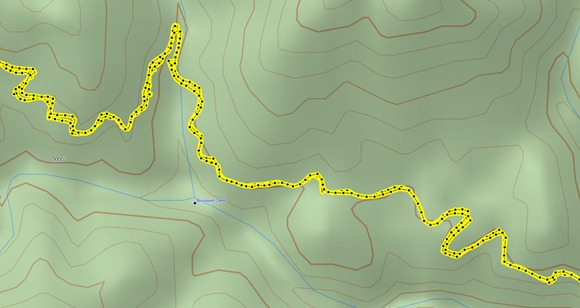


I have been wiating for this report. It is really helpful for me. Thanks, Thanks and Thanks.
Glad it helped!
Thanks for the review. Can you tell me whether Birds Eye Imagery is available for african users?
Many thanks
It should be, but I’m not sure what the resolution will be. You can try it yourself in advance…
https://buy.garmin.com/support/searchSupport/case.faces?caseId={49179a70-5310-11df-6ec9-000000000000}#
Sorry that wrapped. Just copy the whole URL.
One disappointing thing that I mentioned on 62s – when you search for an address or other POI you could go to that point or just save it in favorites (in 60csx, Dakota and Oregon). In 62s you can only go directly to that point right now, or I did not find how can I store the search result in favorites.
A small update. I have found this functionality. Find an address -> Menu -> Review Point -> Menu -> Save as Waypoint. Yahoo! 🙂
Did you get a chance to test the USB port speed on 62? I’ll probably only need to load maps once, but between geocaching and trail GPX’s I’ll probably be using the port pretty freqently and some of the files can get pretty big.
That could make the difference between a 62 and a 62s, especially since with the 62s you get a spot for a micro SD (which means you can bypass the USB port completely and upload GB’s of data in a couple of minutes).
No, but it seems like I read recently that Garmin had increased the transfer speed on some units in recent firmware updates. Any readers recall that?
What happened to WhereIGo?
I think it got up and went.
Good review, Rich – thanks. I think I’ll wait for the firmware situation to resolve itself before I buy one.
Did you have any problems with WAAS reception?
Maybe on the initial firmware (don’t really recall), but it works fine on 2.40 and 2.44.
Rich,
Thanks, The review was helpful. I’m looking forward to receiving the 62st.
Glad it helped. Let us know what you think once you’ve had a chance to try it out.
Rich,
Your reviews have been so helpful. Im looking to pick up a handheld unit and from what I was hearing before some of your reviews was that the 62 series is the way to go, especially for some deep woods back country hiking and biking. Now i’m not so sure. How does the reception of the 62 series compare with the 60 series and the Oregon 450s? I’ve heard that the Oregon series won’t be able to pick up a satellite as well as the 62 or 60 series and will most likely lose reception in woods and valley’s of the Shenandoah mountains in VA. Whats your thoughts? Thanks
Josh,
As an owner of the 60csx and former owner of the Oregon 450t I can honestly say that the 60csx is the best, the Oregon did fine with its satellite lock, but there are questions about Oregon’s trip odometer’s accuracy at low velocities (less then 3mph). But I’m looking forward to getting my new 62st!
Dave,
Thanks for the insight. I’m leaning more towards a 62s because of the supposed superior antenna since ill be using it in some thick woods but Im looking for a unit to use for street nav on a motorcycle, tracking mountain biking trips, hiking, and geocaching. The ease of use on the 450s is definitely nice but from what I’ve heard ill lose reception in the mountains while that won’t happen with the 60CSx or 62s. Does that sounds about right? Does the 450 lose reception in the thick woods of a valley?
Josh,
All my testing is now done in the Southern Appalachians. The Oregon 450 has no significant problems here. Check out my tests at the end of my review…
http://gpstracklog.com/2010/04/garmin-oregon-450-review.html
Josh,
All I can tell you about the Oregon is that of my experiences when compared to the 60csx. When I reviewed the tracks laid down with the Oregon and the 60csx, the Oregon had more straight sections of the track — lost satellite reception. The Oregon seems to record lost satellite as stopped time, and doesn’t record distance traveled on the trip odometer. Oh and I live in northeast Ohio with just as much heavy tree cover as any other place.
On the Oregon you can find accurate distance in a “Rube Goldberg” type of way — of saving the track and then recalling it up and then hi-lighting it to see your distance traveled!
But if you are paying $400.00+ dollars for the top of the line unit, you shouldn’t have to do a “work-around”! Take my comments for they are worth. It is after all your money!
Hello, thanks for your excellent work
it´s very important for me, and for yours, know if this gpsmap 62 series can record tracklogs whith time date, the time info don´t record in tracks stored in olds GPS unit, for example in 60Csx for store tracks whit time date only tracklog to PC discharge will be operate.
The time date on tracks will be very important for GEOREFERENCE photos etc, and for travels over one or two days when we lost this important info on old Garmin series.
This perfonmance i´m sure it´s implemented on OREGON and DAKOTA.
thanks for your attention
Do you mean saved tracks? I don’t believe the 62 series strips any data out of saved tracks. It certainly doesn’t truncate them like the 60 series does.
ealef,
I don’t know what other people are talking about saved tracks being stripped of info like time etc. In fact the 60 csx and the 62 save all tracks in a gpx file on your micro sd card. If you read your manual you will learn to access the memory card and see all the saved raw data.
60csx saves track data in GPX format only if you previously checked “Log Track To Data Card” option.
Doh!
well,
Details, details…that’s what a manuals are for.
Dave and Sergey, thanks for filling in the gaps in my less than complete answer!
The statement about the manual may be true about some things you want the GPS to do but for geocaching the manual STINKS. I love the GPS I have a 62s but I have to learn it all on my own. The MANUAL is ZIP….!!!!
I have purchased a new 62S. I attempted to download the free Arizona topo map from gpsfiledepot. Seems like the 62s is not recognized as a valid gps. Is anyone else having problems with this?
The .exe file should install it in MapSource. If you don’t have MapSource you can install it this way…
http://www.gpsfiledepot.com/tutorials/how-to-install-mapsource-if-it-didnt-come-with-your-gps/
Once you have MapSource, and the AZ topo installed, you can use MapSource to transfer it to the 62s.
If this isn’t the problem, please let me know.
We had no problem putting the mapsource on our home computer. We attempted to download to the 62S gps and the gps has a message on it regarding not being able to unlock the maps.
That’s weird. Those maps shouldn’t be locked. I’d suggest asking at http://forums.gpsfiledepot.com/
I wish someone that has both an iphone and a gpsmap unit would put them down on a picnic table outside and take a phone of the lat and long that each unit displays. I’ve alway been interested to see how much difference with would be between the position indicators.
Geek.com did something close to what you want in their 62s review – they compared the 62s to the iPhone using the Magellan GPS-enhanced case, which should have improved its results. The Garmin was better than the enhanced iPhone.
http://www.geek.com/articles/gadgets/review-garmin-gpsmap-62-handheld-gps-device-20100810/
Rich,
On the 62st, where do they store user created waypoints? does the unit share all the waypoints like the older 60csx? The reason why… in Basecamp it does things differently then the older Mapsource?
Waypoints are stored in the Garmin/GPX/ directory. I’m not sure what you mean by share waypoints. BaseCamp handles file transfers a bit better than MapSource for the newer units like the Oregon and 62/78 series.
Rich,
I took my new 62st out with my older 60csx and my friend has an even older 60cs unit. His numbers were identical to my csx, but the 62st numbers were quite a bit off. The ST has the beta 2.44 version. All 3 units are set up the same way to record the track data.
Here are the trip odometer numbers… the csx values are first.
Trip odometer: 6.4 — 4.9 miles
stopped time: 9:52 — 17:08 min
moving time: 2:15 — 2:09 hrs
Moving speed avg: 2.8 mph — 2.3 mph
Overall speed avg: 2.6 — 2.0 mph
Saved track distance: 6.24 miles — 6.2 miles
The uploaded tracks (to the computer) overlay each other identically. The 62st tracks had 300 more way points laid down then the 60csx.
Yeah, the 62 series has issues with the odometer at slow speeds. Even though tracklog distance seems accurate. Are they both set to automatic track point interval?
Rich,
Both units are set to “auto” and “most”.
I am sitting on a Colorado 300, that for the most part, has done the job for me.
Is it worth upgradeing to the 62S now and install the latest beta firmware, or should I (would you) wait until this supposed creaking issue is resolved?
I liked your review, very helpful, but I’m still kinda on the fence here.
I don’t think the creaking issue will be resolved until we get past the first manufacturing batch. There are definitely still some bugs. I took a ride with v 2.50 loaded the other day, and am still seeing tracking errors in the 100′ range. Even so, that’s better than what 2.40 was producing!
If you want mature firmware, I’d go for the Oregon 450. Or, if you’re the patient type, you could get the 62s. Not sure that’s much help, huh?
Im looking for alaska topo maps. and i cant find any in the 1:24000 range. i know garmin does not have any but is anyone aware of any good topo maps with rivers lakes and peaks of some detail???
Most of Alaska isn’t mapped at that scale, only urban areas are. Here’s a 1:63,360 scale map (based on USGS topo data):
http://www.gpsfiledepot.com/maps/view/302/
In my old 60CSx as well as in my new 62s I cannot find out how to get information about the next turn up on the screen when navigating. The information comes up just before the turn – but when you are driving on the highway there might not be time enough to find the right lane.
On the 60CSx I used the page “`Turn Preview” as a workaround – but as far as I can see that page is not found on the 62s. Is this correct or is just me that cannot find it?
Overall I’m surprised that there is no datafield that would show a small arrow showing the next turn.
Regards Anders Northeved
Hmm, I haven’t used a handheld for street navigation in a long time. Do you have the automotive profile enabled?
Yes I have the automative profile enabled.
It seems so obvious to have a data field that would show the next turn, that I find it difficult to believe Garmin has overlooked it – so I’m still thinking it’s me who cannot find it – but I cannot find it.
Hmm, I don’t have any highway maps loaded. Does the Turn data field give you an arrow or just degrees?
The data fields I have investigated as “potential interesting” are:
* Bearing (direction from current location to destination)
* Course (direction from starting location to destination)
* Heading (cirection you are moving)
* Pointer (Arrow points in the direction of next waypoint)
* Turn (a “L” or “R” and degrees)
… but none of those tells you where to turn next. The funny thing is that the information is there in the “Active Route” list when you press “Enter” – but you can’t do that after each turn.
As you say “Turn” seemed to be the most promising, but just like “Pointer” it gives you general directions towards your next waypoint – irrespectively of where the roads are going.
How about this?
Setup > Routing > Guidance Method > Prompted.
Nope, sorry, I think that will just ask you if you want on road or off road.
Hi Rich, great review. So I’ve been on the fence about buying a 62s for a month or so and just finally got one 4 days ago. I love it. I really wanted to hold out on this purchase, after hearing about quite a few software issues plus the squeaky case. As soon as I got it, I downloaded the 2.60 software upgrade, and went for a 20km hike in the mountains. It worked great, with excellent accuracy; as well the elevation/compass/routing is as good as my Rino 530HCx. I will say, that in the city, it has a bit of a wander while stationary, but not on the trail. And with the case, if you squeeze the sides of the case with a fair amount of pressure, it does squeak; but during normal use and operation, it’s fine- it doesn’t squeak when I press hard on the buttons and that’s what counts. I really tried to give myself a reason to take it back, but honestly, I’m happy with my purchase. I’m writing this for anyone that is also on the fence and just needs to hear that it’s worth the upgrade.
Glad you’re happy. It’s my primary unit now, even though I recently bought an Oregon 450 too! Thanks for sharing.
just downloaded the new 2.6 update last week. The update appears to have improved low velocity trip odometer. Can’t wait to take it out for more hikes. If this update solves the problem of the trip odometer, then kudos and congratulations to Garmin for responding to their customers.
Yep. Now lets find the things it broke! 😉
I’ve just started playing with my new 62s. The first strangeness I noticed: when projecting a waypoint it looks like you can input whole degrees only, no decimal or other fraction notation is possible. Am I doing something wrong?
No, that appears to be the case.
Has Garmin made any suggestion that they plan to address the 62’s creaky case issue? I’m certain any software concerns will be resolved via future software upgrades, but the creaks are somewhat of a deal breaker for me. I would buy one today if that issue was resolved.
I’m betting subsequent production runs will fix this. Are you near a high turnover merchant (like REI) where you can go try one out?
Hi Rich,
Yes I am, just north of Seattle. I did try one at REI last week and it had a severe case of the creaks, but it was the display model though. I’ll check out an unopened 62s this weekend and hopefully………? Thanks.
Would love to hear (pardon the pun) the results.
Of the 2 REI stores I visited, the first had creaky units. At the second, which was the larger down town store and probably higher turnover, the first unit I checked out was rock solid. The case was very rigid and had no give at all when firmly squeezed, quite a difference from all the others, so the purchase was made. In conclusion, it seems Garmin may have rectified this issue (?) or I just got lucky. The SN# 21F02xxx
Hi.. please recommend — want GPS like Garmin 62s or 60 or other version like Oregon or Dakota that would work best in conditions with canopy, high density of trees for hiking on the appalachian trails in WV, VA, MD areas or mountain biking for example. I do not want the unit that work in a big city but on the mountains. Please recommend the Garmin series which work best on such conditions. I found 60s is not that bad but I am new and need advice. What type of Topo Map if needed one?
I would go with one of the new models. The advantages are just too many — I especially like the custom maps option and the improved track navigation. I’d recommend the 62s if you spend much time mountain biking, as it’s easier to change screens on the fly. The firmware may not be quite as mature as the Oregon series, but it is very close and should catch up shortly. I spend my outdoor and testing time in the Southern Appalachians BTW. You might want to read this…
http://gpstracklog.com/2010/09/update-on-garmin-gpsmap-62-series-performance.html
@Doug — Thanks for the report. I’d love to hear how you like it after you have some time to try it out. I find myself carrying it more than my Oregon 450 these days!
Well, I looked at all the reviews of the Garmin 62s and I decided to bite the bullet and plop down the money. I have owned Magellen units in the past and have been very happy with the overall performance, but I wanted to give Garmin a try this time. Upon recieving my new unit, I put in the batteries and turned it on. I was very disappointed that I could barely see the screen. I turned up the back light to the max which helped a little, but when the light timed out, my screen was all but gone. I went outside in the sun and that helped a little, but it was alot of work to view the screen. If I wanted to use it for vehicle navigation when I go off roading, I would have a very difficult time following the directions. Am I doing something wrong or is there possibly something wrong with my unit? All the settings are factory default, except of course for the back light which I increased. The images of the screens on your website show a nice, bright clear screen, but mine is no where near that. And, by the way, I have perfect eyesight.
Thanks
Like all transflective TFT screens, you either need the backlight on, or need to be in bright enough light for it to reflect light back to you. Was your Magellan set to always have the backlight on? Which model did you have?
You can change the backlight timeout by going to Menu > Menu > Setup > Display > Backlight timeout
If it doesn’t look as good as my full sun pic above, you could have a defective display, though I can’t imagine what the defect would be.
Hey Rich, thanks for your response. I only used my backlight on my Magellan devices when I used them at night, otherwise they remained off. I had 3 Magellan models over the past 10 years, the 315, the Colortrak and the Meridian. I never had a problem seeing the screens on any of them. I still own them all. I think my next step will be to contact customer support and see what they recommend.
Thanks
Bill
Hi There,
I’m having a bit of trouble deciding between the 62s and the Oregon 450. Help!! What should I consider? I’ll be using it in pretty dense forest in the Cascades while looking for mushrooms. I’d like to be able to set points so I can return to the exact spots in later years…
Thanks for your help in advance!!
Have you read this…?
http://gpstracklog.com/2010/07/garmin-gpsmap-62s-or-oregon-450.html
It may help. They are both good. I’d give the Oregon a bit of an edge for accuracy, but the 62 series may prove better once the firmware matures a bit.
Does the 62S support a maximum size of MicroSD Card? It looks like 4GB, but that seems awfully small for such a new unit.
I’ve heard of people using at least 16GB cards in the new Garmin handhelds.
Where did you find the 4GB limit? I have 8GB in my 62s and have no problems of any kind.
Hope it helps. Cheers. Luciano.
I need a GPS that I will mount on the handlebar of my off-road motorcycle in S.E. Asia. It will have to endure hour after hour of grueling bumps, mud, etc as I negotiate the backtrails of Cambodia. Would the 62S or the Oregon 450 be the better choice? Thanks.
They are both pretty rugged. The Oregon has a bigger screen (target) for cracking, but the screen is recessed a bit, giving it some extra protection. Personally, I’d probably go for the 62s for this use, just because it’s easier to switch screens without having to look at the unit. This might help..
http://gpstracklog.com/2010/07/garmin-gpsmap-62s-or-oregon-450.html
I would like to start at a known point and input a bearing (from true north) and a distance (on the order of 300 feet), and then go to the new location with an accuracy of somewhere around 10 feet. I’ve been looking at the Oregon 450s and the 62s, but cannot conclusively determine if this can be done on either model. How can these inputs be done (Sight n’ Go?) and which model do you recommend?
I can’t vouch for the accuracy, and I have seen reports that it won’t be as good as what you are looking for. But both models have this capability. You create a waypoint, then use the menu and choose Project Waypoint.
I’m looking for a gpsr to use for primary use on my motorcycle (street) as well as use for geocaching and hiking. I’ve been looking at the 60csx (due primarily to cost), but am wondering if I might be better served with a newer model. Having said that, I’m thinking the Oregon 450 might serve my purposes best, but am worried about the brightness of the screen in bright sunlight. What would you recommend? 60csx, 62s, Oregon 450 or other?
If you can use external power on the Oregon on your motorcycle, I think it will be fine. Fixed mount use is the worst case for visibility, but that would solve it. When it’s in your hand, people tend to tilt it for the best viewing angle without really having to think about it.
This might also help… http://gpstracklog.com/2010/07/garmin-gpsmap-62s-or-oregon-450.html
Hey Brian
I bought a 62s about a month ago and I also bought the bicycle holder and a 12 volt adaptor. I don’t care for the unit because it’s too hard to see and I plan on getting rid of the whole package for 280 bucks. If that fits your budget let me know. I ended up buying the Magellan explorist 710 and I like it much better.
Bill
Wow, I’m a bit shocked. Because of screen size?
Well it’s a combination of screen size and the visibility. I just really have to move it around in the sun at just the right angle to really see it well. Not good for fixed mounting on bike, motorcycle or shaded areas, such as in a canyon or under a tree (canopy). It’s ashame that with current technology that a screen can’t be made that is more visible. I like the capabilities of the unit, just don’t like the screen.
I’m just surprised, because we seem to be having very different experiences with the same units. I just tried them both side by side and the Garmin is as bright or brighter no matter how I test it.
I have to agree with Rich on this one. I love the 60csx, Garmin really did improve the 62s. I’ve tried the Colorado series, and the Oregon model, and my friend has the Magellan. I have to say the 62st is the best out of the group on many different levels including viewing the screen under trees, in sunlight or any condition.
Bill if you still have it I am interested. Reply here and we can go from there.
Thanks
I do. 951-522-6104
rlyindra at yahoo dot com
Has anybody found a way to start/stop the navigation of the 62s? The only option is to switch the unit on and off: not the best solution. There are situations when you need to reset everything (trip computer, tracks, elevation graph) and start the recording at a well defined instant (think of a competition). You might need to stop the recording and resume after a while. Looks like the 62s sw is not designed to cover most of the uses it could be useful for.
To stop navigation, you can just press Find > Stop navigation.
To clear data and start a new track, I typically do this… From the Trip Computer screen, press the Menu button and then choose Reset.
Here’s another option…
http://garmindakota.wikispaces.com/message/view/home/31649379#31665035
It would be nice if Garmin would offer a pause function.
Thanks Rich for your suggestion. Very bad implementation of a mandatory function (Start/Stop/Pause). The older units (GPS III Plus, GPS V, 278C)had a much better software.
It looks like the sw of the recent models has been designed with a toy in mind.
One thing I’ve noticed in testing the Magellan eXplorist 710 is a pause track function. I can guarantee you they’ll get kudos for that in my review!
rick, I have a garmin 62 s and have a problem putting in way points with the “white arrow”.
with old 76 cs if I scrolled on map to a point and then tapped lightly the “mark” button, unit would input a way point that I could navigate to. Now if I hit the mark button lightly or press firmly it gives a way point for exactly where I am, not where I want to go on the map. Is there anyway for me to, in the field, to manually input on map a way point at a position AWAY from where I am at that time. many thanks dave
Pan the map to the desired location, then press Enter > Menu > Save as Waypoint. Press OK, then press Go to navigate to it or Menu > Edit Waypoint to change the name.
rich, the answer is perfect and I sincerely thank you. wouldn’t it be nice if garmn manual described the method…or better still that their tech. service could answer my question. they could not!
happy everything, dave
hi
It has much better features than 76cx that I had before but I have a problem with it’s track menu how can I use it for start and end point. there is no ‘on’ and ‘off’ buttons in comparison with 76cx
can sb help me?
thanks
Are you trying to do a Trackback or follow a pre-loaded track?
hello
I tried to do that but I don’t know their priority.
Is that possible to explain the steps of tracking of two seperate pathes?
best regards
Which did you try? Were you trying to follow the current track back to your starting point?
Rich, I think what Amir wants to do is turn on tracking, turn it off and save that track, then clear it and record a new track (like you could with the old GPSMap models). It’s my understanding that there’s no easy way to do that with the 62s, but as I’ve just received my shiny new 62s from EMS, I don’t know that for sure.
Try the Garmin Oregon wiki to see if it has some info on this:
http://garminoregon.wikispaces.com/
Thanks Leszek. Glad you got the EMS deal too!
Since I sell two programs that create maps for those newer models, at some point I knew I’d have to buy one of them. As you know, I’m not a big fan of the touchscreen models, so this was the only real choice (since there’s no good rugged Android GPS out yet).
So far, I’m reasonably happy, with some exceptions. I’ll find one feature that’s cool, then I’ll find some retarded interface quirk that drives me nuts (e.g. why can’t you Enable/Disable mapsets just by selecting them and pressing Enter to toggle their status? Why do you have to bring up a separate screen, select Enable or Disable, then press Enter? And I appreciated you explanation of how to create a waypoint at the cursor location, but why do you have to press Menu to get to that? Why isn’t “Create Waypoint” one of the options that shows up automatically – there’s more than enough room on the screen to fit) … and so on.
I did discover that USGS topo maps created with the BMap2MP utility in Moagu work fine on the 62s (and presumably on other similar models as well). Quality isn’t as good as Custom Maps, but there’s no size restrictions on those maps, so you can load in dozens of topo maps without issue, and still have room for a Custom Map overlay as well. I’ll add a section to the help file that goes into this process for these new Garmin models in greater detail.
Thanks Leszek. I hope you’ll do a post on using BMap2MP/Moagu with the 62s!
Doesn’t really fit the “free” theme of my site ;-). But I have extended Tutorial Four in the help file, and added Tutorial Five, that describe the process of converting a standard topo map into a .img file, how to install it on a 62s (or any other compatible unit), and how to combine multiple map files into a single one. Because of the ability to have multiple .img files on a Garmin, not just a single gmapsupp.img, installing topo maps is a simple drag-and-drop process – don’t have to install it on MapSource/BaseCamp anymore.
Doh! Do you have a web page with this info on the Moagu site? I’d like to link to it.
On the Moagu website, the compatible units page talks a bit about it, along with screenshots from an Oregon and my 62s:
http://moagu.com/?page_id=9
The FAQ page mentions it briefly as well. But for full info, the Tutorials in the help file are the best guide. It’s really easy to convert a topo map to a 62s-friendly file:
1. Download a topo map from libremap.org
2. Remove the map collar with Moagu’s utility.
3. Start up the BMap2MP utility, and load the decollared GeoTiff
4. Enter a name for the map, and starting map tile number; check the box for the 800-ft. zoom level.
5. Create the map code (takes about 45 minutes).
6. Compile the map code (the new mkgmap compiler drops this time from the old 4 hours down to 4 minutes, with no watermarks).
7. Drag and drop the combined .img file into the Garmin folder on your unit.
8. View the map! You’ll need to zoom down to the 800ft zoom level (200m) at Normal detail level to see it, but you can modify the first zoom level by increasing Detail to More or Most.
Leszek Pawlowicz exactly understand what i mean.
In 62s I follow these steps for taking two seperate tracks
1- open the track manager
2- in current track menu select the clear current track
3- then i start my owen new track
4- track manager\current track\save track
5- for a new track i repeat steps 1-4
Are these steps arrangment is correct?
What is the function of stop navigation?
Is that for ending one track?
Thanks.
Yes, that will do it. Stop Navigation does nothing to the track; it only ceases navigating to whatever waypoint, etc. you are navigating to.
Even though it is aimed towards the Oregon series, you may find this helpful…
http://garminoregon.wikispaces.com/Tracks
I currently own a standard eTrex Legend and as I have recently started geocaching, I decided to upgrade to a newer GPS. I am on quite a limited budget so I was looking at the 60csx on ebay but I am now not sure whether to buy a 60csx or wait for the price to drop on this. The problem is that I don’t think that this will drop into the price I am willing to pay for quite a while.
Have you considered the Oregon 450 instead? The sale prices have been much more reasonable on them.
I had a look at the oregon 450 and it is still out of my price range. I live in the UK and have a budget of about £200 maximum. I can get a gpsmap 60csx for less than this on ebay but I have not be able to find a 62s or an oregon 450 for less than £250. I have looked at a dakota 20 but it isn’t NMEA compatible and as I may use it on my boat as well, I need it to have this.
Nick,
Not being an expert, but simply a Garmin user, you might want to check Garmin’s warranty policy first. I think the warranty does not cover units purchase on auction websites.
Oh I have been using the 60cs then the 60csx since it hit the market in 2004. I’ve tried the Colorado series and the Oregon 450s, they didn’t match up to the 60csx. I currently own the 62st and love it. If you are short on the money save up for the 60csx, it is well worth it.
You are right about the warranty as Garmin only cover products where you can provide the original sales receipt. I will ask the seller of the gps I am planning to bid on if he can include the original sales receipt and if not I may sacrifice the warranty for a good price or I may decide to pay more to get it with warranty. It depends how cheap I can find it elsewhere and if any other people selling this on ebay can include the original sales receipt.
Have you considered the 60Cx instead? I personally don’t think the altimeter and digital compass on the 60CSx are worth the extra dollars, and Amazon-UK has the 60Cx new for about L200. If you have a friend in the US, they could even buy one for you for only $170 US and ship it overseas.
I have considered the cx but I think the barometric altimeter and electronic compass could be quite useful for hiking and geocaching. I have also considered buying from the us but I don’t know how much import tax would be.
I just bought a new 60csx for £124 ($194) on ebay. This is a lot cheaper than I expected to get it so I don’t mind having sacrificed the warranty.
I recently purchased a 62S and am very happy, but, I was wondering whether anyone else has noticed the low volume of alerts and beeps on the new 62S. Is there a fix or a way to increase volume? When biking or hiking near water flow or any car noise it is practically impossible to hear proximity alerts. Can it be fixed with software upgrades? Or is there some secret to increasing the volume when needed?
Thanks guys
I’ve seen one report saying the current firmware made them softer, but I don’t know if it is true…
http://garmingpsmap.wikispaces.com/message/view/home/32141968
Some tones are louder than others, but there are no volume settings.
Thank you for your response, I contacted Garmin and the response was as follows:
From Garmin International— Sorry, but there is no way to increase the volume of the alerts. If your alerts are as low as you are stating, I would try to go in somewhere local and compare your unit with a display model. You may have a defective unit if the alerts are extremely low. In my opinion, the alerts are pretty noticeable. If you have any further questions please contact us. —–
I have yet to try the comparison they suggested. Maybe mine is defective, I don’t know yet. But, since several others have also questioned the volume, maybe after enough response, If indeed there is a problem, a fix could be made. Maybe it’s just my ears, but I think I have excellent hearing. Again, Thanks.
@Dave Tobiasz – Are you following this thread? I was hoping you might take a crack at answering this comment, since it seems like you pay close attention to the low velocity issue, on the 62s at least…
http://gpstracklog.com/2010/07/garmin-gpsmap-62s-or-oregon-450.html/comment-page-1#comment-127562
Rich – Thank you for this site….very informative! Been very useful to me!
I’m pondering the purchase of a second GPS. I use the GPS for my families off road activities, we ride off road dirt bikes, and 4 wheel side x sides (rhino UTV’s) off road primarily in Arizona and Colorado. My present unit is a Garmin GPSmap 60cs, Find it more than adequate for my needs (other than some direct sunlight issues in visibility, and a larger screen would be nice)I use Base Camp and EasyGPS, and 24k Topos from GPSfiledepot. We track all rides then upload to Base camp and edit and save for future outings, and to share with friends we ride with. When planning rides we sometimes include several past rides (tracks) then download to GPS. For this use the 60cs works very well. Would like to buy an additional GPS for an additional unit on rides (would be helpful in dusty conditions for second rider or group to be able to also know the route (track). I have thought about the following and would like your opinion….Nuvi 500 (larger screen – believe it lacks some of the track ability) Oregon 450 (larger screen) GPSmap 62s and or GPSmap 60csx. Are you aware of any device that one could put on each rider or bike/utv that would track it on the GPS units…that would be extremely helpful on a ride. Thank you in advance for your comments….
Sounds like you use your GPS similarly to me — loading and following tracks, etc. You’re right — I wouldn’t go with the nuvi, since you can’t load tracks to it. I’d favor the Oregon 450 or 62s over the 60CSx. BirdsEye aerial imagery and Garmin custom maps capabilities are nice, but I find this feature very helpful…
http://gpstracklog.com/2010/07/navigating-tracks-on-the-new-garmin-handhelds.html
The Rino series will let you track other riders with Rinos, but its getting a bit long in the tooth, and it wouldn’t surprise me to see it updated this year with the Oregon/62 series features. The DeLorme PN-60w is supposed to get this feature in a firmware update, but the range may be limited to 1/2 mile or so.
Thank you Rich! 450 versus 62s…. I have read your reviews on both….I guess the only issue is screen issues with direct sunlight…thoughts? I kind of lean towards the 62 because of the similarity with my existing 60cs.
mike
I don’t know if you saw this post or not…
http://gpstracklog.com/2010/07/garmin-gpsmap-62s-or-oregon-450.html
The 62s is easier to use on the fly. You can switch screens without looking at it, which is why I prefer it to the Oregon for mountain biking. And its brighter. OTOH, if you can rig external power for the Oregon, it gets rid of the brightness issues and gives you a nice big screen.
I wasn’t aware that the 450 connected to external power corrected brightness issues…..does this mean when connected it is viewable in full sunlight? Would it make it better in sunlight than 62s?
I think so. It should be as bright, if not brighter. Plus you have the bigger screen.
I haven’t tried it with the 450, but my old 400t was MUCH brighter in the car when plugged in.
Maybe somebody can explain the following behavior of my 62s.
Yesterday I hiked a cross-country route. Started ad an elevation of 1768 m,reached the top at 2206 m. and went back at the starting point following the same path. The elevation plot is perfect, no interruptions, no jumps, but the Total Ascent shows 228 m, I was expecting at least 438 m. The Total Descent shows 450 which is close to the expected data.
Thanks.
Are you using the latest firmware? This has been a real problem with the Oregons and now the 62 series. One firmware version and it’s as good as the 60CSx for reporting total ascent. The next version and they break it again. Rinse and repeat, ad nauseum.
Software version 2.80
You could try the 2.92 beta, or just wait for the next release. I wish I had other suggestions, but I don’t.
Thanks Rich, I really appreciate your prompt help.
Last weekend I tested the 2.92 beta. On a 10 Km cross-country sky track (same starting and ending point) I got: Total Ascent 288 m, Total Descent 498 m!!! My impression has been confirmed: the present version of GPSMAP 62s is a toy, not a precision instrument.
Rich,
Thank you for your review. I just updated my 60csx for a 62s. You mentioned in your article that you can view multiple tracks at the same time. I can’t figure out how to do that on my unit. Please explain how to do this.
Thanks,
Michael J
Go to Main Menu > Track Manager. For each track that you want to display, select “Show on map.”